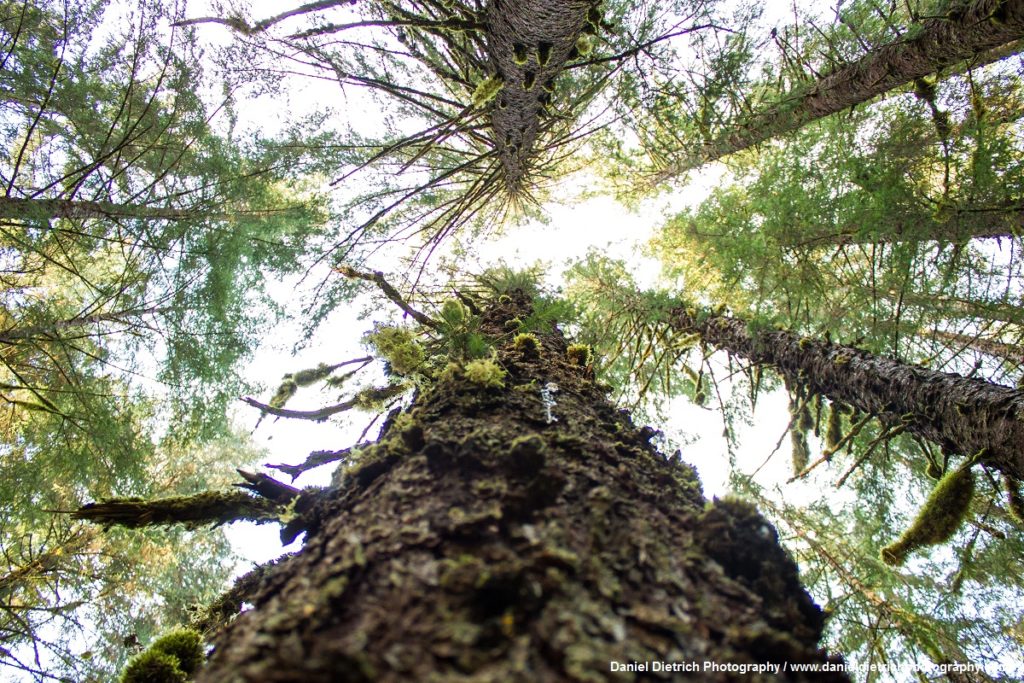Keep Roadless Rule Protections In The Tongass

(This piece originally appeared in The Hill.) Alaska state officials and the Alaska congressional delegation have attempted to force on Southeast Alaska communities and the region’s economies something they don’t want or need: a revival of large-scale clear-cutting.
Top: Looking up into the Tongass canopy. Western hemlock and Sitka spruce are the most abundant trees in the forest — Sitka spruce can reach heights of 200 feet or more. (Daniel Dietrich Photography)
Nearly two and a half years ago, the U.S. Forest Service finalized an updated management plan for America’s largest national forest, the Tongass in Southeast Alaska.
This plan recognized the importance of conservation in the Tongass by identifying high-value salmon watersheds, inventoried roadless areas and other conservation lands where logging should not occur. It was an important step forward in transitioning the Tongass away from decades of taxpayer-subsidized industrial old-growth logging, a transition that had already begun organically as billion-dollar sustainable industries like fishing and tourism have developed.

Between then and now, however, Alaska state officials and the Alaska congressional delegation have attempted to force on local communities and the region’s economies something they don’t want or need: a revival of large-scale clear-cutting and an attempt to resurrect an industry that supports less than 1 percent of the region’s economy. They are seeking a state exemption from the 2001 federal Roadless Rule and have pushed a variety of legislative vehicles that would put Tongass old-growth at risk.
In doing so, they have ignored the recommendations of the very people they represent, including the Tongass Advisory Committee (TAC), which helped guide the Forest Service as it finalized its revamped management plan and was made up of local representatives including government, timber industry, Alaska Natives, conservationists and others. They have also chosen to ignore the more than 165,000 people that commented on that plan, many of whom urged the Forest Service to pursue a faster end to large-scale old-growth logging, and the more than 1.5 million people who voiced support for strong Roadless area protections during the original Roadless rulemaking process.

Recently, efforts to keep Tongass old growth trees standing have picked up steam, as Sen. Maria Cantwell (D-Wash.) and Rep. Ruben Gallego (D-Ariz.) introduced the Roadless Area Conservation Act in both the House and Senate.
The Roadless Area Conservation Act would codify the Roadless rule into law, preserving roadless areas across the country for hunting and fishing — activities that support a subsistence lifestyle and define a way of life for many people living in rural forested areas. It would help fight climate change impacts — the Tongass alone absorbs approximately 8 percent of the nation’s annual global warming pollution — while protecting imperiled species that rely upon Roadless areas for survival and preserving special places that Native American and Alaska Native communities consider sacred. It will support outdoor recreation and tourism industries that thrive when forests are valued for their many ecological benefits.

In Alaska, the Roadless rule protects Tongass old-growth while also providing for community access, hydropower projects, utility connectors and other economic development projects when they serve a legitimate public interest.
The state’s request to create a state-specific rule in the name of meaningfully addressing local economic and development concerns was never anything more than pretext for continuing to prop up an old-growth timber industry that can’t survive on its own. Keeping the Roadless rule in place will continue to help strengthen Southeast Alaska’s economy while maintaining the health of our forests and the communities and wildlife that depend on them.
Our country’s old-growth forests and their intact roadless areas are the last vestiges of America’s truly wild places. Clearcutting 800-year-old Sitka Spruce trees in the Tongass will fragment wildlife habitat, impact valuable salmon streams and open the door to invasive species.

We should be embracing the value of our national forests, which in Southeast Alaska extends far beyond simply leveling forestland and exporting old-growth logs to other countries. We should be preserving these trees and expanding our forests as a bulwark against climate change, not following the Trump administration’s lead by gutting policies essential in the climate change fight.
If Congress is willing to look long term, keeping the roadless rule in place will help maintain the health of our forests and the communities and wildlife that depend on them.
